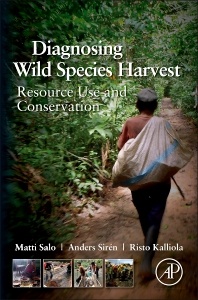Diagnosing Wild Species Harvest Resource Use and Conservation
Auteurs : Salo Matti, Sirén Anders, Kalliola Risto

Diagnosing Wild Species Harvest bridges gaps of knowledge fragmented among scientific disciplines as it addresses this multifaceted phenomenon that is simultaneously global and local. The authors emphasize the interwoven nature of issues specific to the ecological, economic, and socio-cultural realms of wild species harvest.
The book presents the diagnosing wild species harvest procedure as a universal approach that integrates seven thematic perspectives to harvest systems: resource dynamics, costs and benefits, management, governance, knowledge, spatiality, and legacies. When analyzed, these themes help to build a holistic understanding of this globally important phenomenon. Scholars, professionals and students in various fields related to natural resources will find the book a valuable resource.
Wild species form important resources for people worldwide, and their harvest is a major driver of ecosystem change. Tropical forests regions, including Amazonia, are among those parts of the world where wild species are particularly important for people's livelihoods and larger economies. This book draws on tangible experiences from Amazonia, presented in lively narratives intermingling scientific information with stories of the people engaged in harvest and management of wild species. These stories are linked to relevant theory of wild species harvest and wider discussions on conservation, development, and the global quest of sustainability.
PART 1 Focus on Wild Species Harvest
1. All Over the Earth, Since the Dawn of Time
2. A Conceptual Primer to Wild Species Harvest
PART 2 Stories from the Forest Floor
3. The Millennia of Wild Species Harvest in Amazonia
4. On a Winding Trail towards Sustainable Hunting
5. Fishing in and Fishing out the Amazon
6. River Turtles – They Have Come Back
7. Palm Leaves, Sustainability, and Dignity
8. Collect Locally, Eat Globally – the Journey of the Brazil Nut
9. Changing the Law of the Jungle – Forests and Forestry in Peru
10. Biodiversity and Business – An Experience with Medicinal Plants
11. Açaí: the Forest Farms of the Amazon Estuary
12. Blank Maps and Desires about Biodiversity Wealth
PART 3 Seven Thematic Perspectives
13. Resource Dynamics Behind the Provision from Nature
14. Costs and Benefits Weighted by Harvesters
15. Management of Resource Systems
16. Governance Shaping Incentive Structures
17. Knowledge for Action and Interaction
18. Spatiality in Nature and Society
19. Legacies from the Past and for the Future
PART 4 Diagnosis and Follow-up
20. Diagnosing Wild Species Harvest – The DWiSH Procedure
21. Whose Interest? Whose Action?
22. Savage, Ravaged, or Managed?
Anders Sirén is a biologist and PhD in Rural Development Studies. From 2009 to 2013 he was a postdoc researcher at the University of Turku, and is currently a lecturer in geography at the University of Helsinki. Sirén has spent over ten years in Ecuadorian Amazonia, where he has conducted extensive field work for social and natural science research related to wild species harvest and land use change in indigenous communities, and also made shorter visits to Peruvian Amazonia. He loves fishing in the swift rivers of western Amazonia and dreams about saving Amazonian fisheries from the multiple threats of overfishing, habitat destruction, and pollution.
Risto Kalliola is a professor of geography at the University of Turku. He has made a long career on biogeographical, ecological and resource management studies in Amazonia and northern Europe. He is interested in the role of scientific understanding in the use of renewable natural resources and in land use planning. Kalliola is one of the founder members of the multi-disciplinary University of Turku Amazon Research team (UTU-ART) which has over three-decades long research history in Amazonia.
- Includes research and report-style narratives describing a wide variety of concrete cases
- Addresses wild species harvest from a holistic perspective including ecological, economic and socio-cultural issues, not limiting the scope to a single type of resources
- Provides theoretical treatment of wild species harvest worldwide, with special emphasis in the most recent scientific understanding on the biodiversity of the Amazonian lowland region
- Presents an objective viewpoint, noting problems the harvest may cause as well as its potential to contribute both to biodiversity conservation and to local livelihoods and national economies
- Coherent, easily followed structure and abundant illustrations help the reader absorb central messages
Date de parution : 01-2014
Ouvrage de 494 p.
15x22.8 cm
Thèmes de Diagnosing Wild Species Harvest :
Mots-clés :
Bertholletia excelsa; Chuchuwasa tree; Irapay palm; Lepidocaryum tenue; Maytenus; Oenocarpus bataua; Pholidostachys synanthera; Ungurahua palm; Wayuri palm; Açaí palm; Accessibility; Acre; Amazon Basin; Amazon River; Amazon estuary; Awareness; Benefit; Bio-geopolitics; Biodiversity; Biological diversity; Bolivia; Boom and bust; Brazil; Brazil nut; Capacity building; Command and control; Commodity chain; Community; Community-based management; Conservation; Consumers; Cost; Cost distance; Costs and benefits; Deforestation; Diagnosing Wild Species Harvest Procedure (DWiSH Procedure); Discounting; Distance; Ecological models; Ecosystem; Ecosystem functions; Ecosystem services; Ecuador; Education; Environmental history; Euterpe oleracea; Extraction; Extractive reserves; Fisheries; Floodplain; Forest concessions; Forest garden; Forest law; Forestry; Geopolitics; Governance; Growth conditions; Harvest; Harvest quotas; Harvesters; Hunting; Incentive structures; Indigenous peoples; Information; Iquitos; Know-how; Knowledge; Land-use planning; Legacies; Legacy; Legitimacy; Logistic growth; Loreto; Madre de Dios; Management; Management planning; Market-based policy instruments; Medicinal plants; Migration; No-take areas; Nontimber forest products; Nontimber forest products (NTFPs); Opportunity cost; Over-harvest; Pando; Peru; Policy instruments; Population; Pre-Columbian cultures; Prehistory; Resource; Resource dynamics; Resource management; Revenue; Science; Selective harvest; Selective logging; Socio-cultural heritage; Spatial bioeconomic models; Spatial variability; Spatiality; Species; Stakeholders; Stock enhancing; Subsistence; Superfood; Sustainability; Technology; Time; Time cone; Trade; Traditional knowledge; Understanding; Urban market; Wealth; Wild rubber



